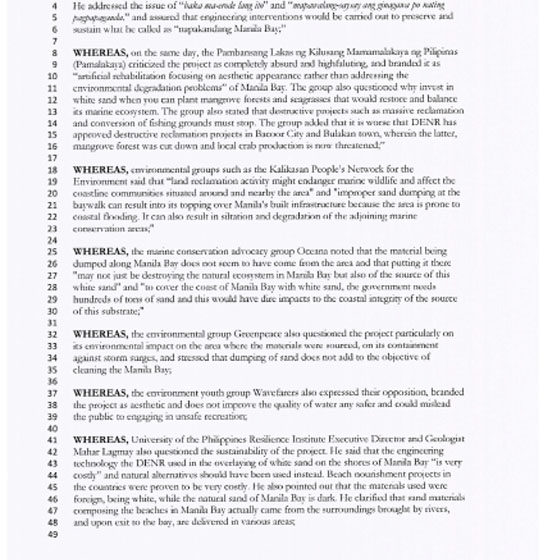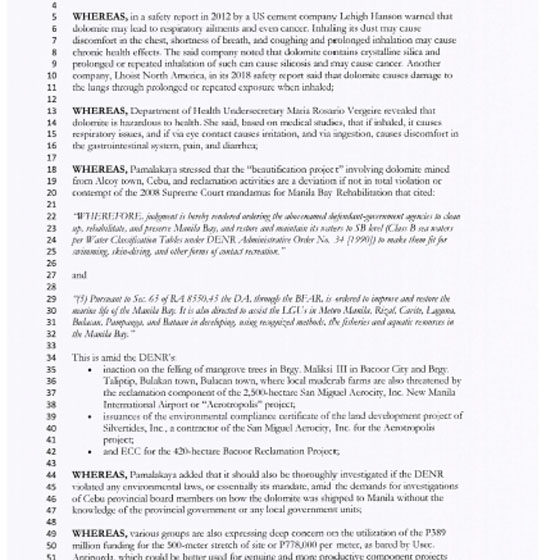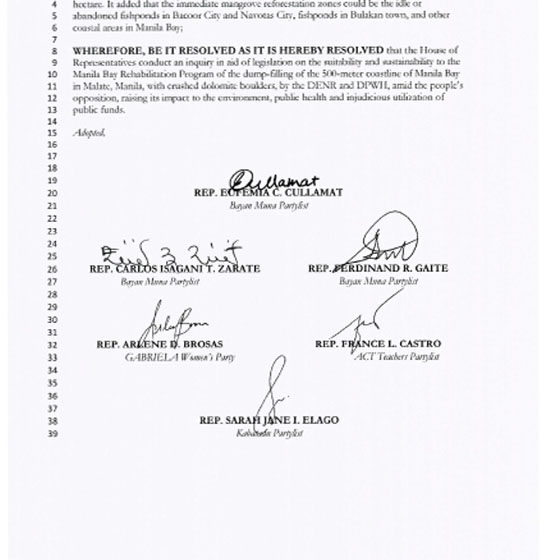Republic of the Philippines
HOUSE OF REPRESENTATIVES
Quezon City
EIGHTEENTH CONGRESS
Second Regular Session
HOUSE RESOLUTION No. 1194
Introduced by
BAYAN MUNA Representatives EUFEMIA C. CULLAMAT
CARLOS ISAGANI T. ZARATE and FERDINAND R. GAITE,
GABRIELA Women’s Party Representative ARLENE D. BROSAS,
ACT TEACHERS Party-list Representative FRANCE L. CASTRO and
KABATAAN Party-list Representative SARAH JANE I. ELAGO
RESOLUTION
DIRECTING THE HOUSE OF REPRESENTATIVES TO CONDUCT AN INQUIRY, IN AID OF LEGISLATION, ON THE SUITABILITY AND SUSTAINABILITY TO THE MANILA BAY REHABILITATION PROGRAM OF THE DUMP-FILLING OF THE 500-METER COASTLINE OF MANILA BAY IN MALATE, MANILA WITH CRUSHED DOLOMITE BOULDERS, BY THE DEPARTMENT OF ENVIRONMENT AND NATURAL RESOURCES (DENR) AND DEPARTMENT OF PUBLIC WORKS AND HIGHWAYS (DPWH), AMID THE PEOPLE’S OPPOSITION, RAISING ITS IMPACT TO THE ENVIRONMENT, PUBLIC HEALTH AND INJUDICIOUS UTILIZATION OF PUBLIC FUNDS
WHEREAS, on September 3, 2020, the public was dismayed by the sudden or unannounced dump-filling of “white sand”-appearing materials at the 500-meter coastline of Manila Bay, in Malate, Manila. It was reported that it is led by the Department of Environment and Natural Resources (DENR) and the Department of Public Works and Highways (DPWH). On a report from PTV News, the project is to be completed before September 19, 2020 or the International Coastal Cleanup Day, and DENR Undersecretary Benny Antiporda said that “Ilalapit natin sa kanila ‘yung white sand. Dito po ay mararamdaman nila na kahit paano ay para bang nasa Boracay na rin sila;”
WHEREAS, on the same day, the DENR released a video statement where Usec. Antiporda said that “On the issue of white sand in Manila Bay, these came from Cebu, but these are not sand, these [are] dolomite boulders na cinrush, (crushed), turned it into sand, bago binyahe papunta rito sa Manila. As clarification, these will be, i-ooverlay siya, doon sa beach area, para makita ng tao, na itong white sand, eh magsisignify ng kalinisan. This will serve as an IEC (information, education, and communication) campaign for the people, to tell them, na it’s about time for us na pangalagaan ang ating kapaligiran at panatiliin nating malinis, dahil naniniwala po ang ating kalihim Roy A. Cimatu, na konektado itong pandemic na ito, sa atin pong pagiging pabaya sa ating kalikasan at sa atin pong kapaligiran.”
Continued, after a brief cut, he announced that this is a “beach nourishment” project of the DENR and the Manila Bay task force, it is Phase 1 of the Manila Baywalk project, that on September 19, 2020, there would be a “principal’s visitation and inspection,” including DENR Sec. Roy Cimatu, Department of Tourism Sec. Bernadette Romulo-Puyat, Department of Interior and Local Government Sec. Eduardo Año, DPWH Sec. Mark Villar, and MMDA Chairman Danilo Lim.
He addressed the issue of “baka ma-erode lang ito” and “mapawalang-saysay ang ginagawa po nating pagpapaganda,” and assured that engineering interventions would be carried out to preserve and sustain what he called as “napakandang Manila Bay;”
WHEREAS, on the same day, the Pambansang Lakas ng Kilusang Mamamalakaya ng Pilipinas (Pamalakaya) criticized the project as completely absurd and highfaluting, and branded it as “artificial rehabilitation focusing on aesthetic appearance rather than addressing the environmental degradation problems” of Manila Bay. The group also questioned why invest in white sand when you can plant mangrove forests and seagrasses that would restore and balance its marine ecosystem. The group also stated that destructive projects such as massive reclamation and conversion of fishing grounds must stop. The group added that it is worse that DENR has approved destructive reclamation projects in Bacoor City and Bulakan town, wherein the latter, mangrove forest was cut down and local crab production is now threatened;”
WHEREAS, environmental groups such as the Kalikasan People’s Network for the Environment said that “land reclamation activity might endanger marine wildlife and affect the coastline communities situated around and nearby the area” and “improper sand dumping at the baywalk can result into its topping over Manila’s built infrastructure because the area is prone to coastal flooding. It can also result in siltation and degradation of the adjoining marine conservation areas;”
WHEREAS, the marine conservation advocacy group Oceana noted that the material being dumped along Manila Bay does not seem to have come from the area and that putting it there “may not just be destroying the natural ecosystem in Manila Bay but also of the source of this white sand” and “to cover the coast of Manila Bay with white sand, the government needs hundreds of tons of sand and this would have dire impacts to the coastal integrity of the source of this substrate;”
WHEREAS, the environmental group Greenpeace also questioned the project particularly on its environmental impact on the area where the materials were sourced, on its containment against storm surges, and stressed that dumping of sand does not add to the objective of cleaning the Manila Bay;
WHEREAS, the environment youth group Wavefarers also expressed their opposition, branded the project as aesthetic and does not improve the quality of water any safer and could mislead the public to engaging in unsafe recreation;
WHEREAS, University of the Philippines Resilience Institute Executive Director and Geologist Mahar Lagmay also questioned the sustainability of the project. He said that the engineering technology the DENR used in the overlaying of white sand on the shores of Manila Bay “is very costly” and natural alternatives should have been used instead. Beach nourishment projects in the countries were proven to be very costly. He also pointed out that the materials used were foreign, being white, while the natural sand of Manila Bay is dark. He clarified that sand materials composing the beaches in Manila Bay actually came from the surroundings brought by rivers, and upon exit to the bay, are delivered in various areas;
WHEREAS, University of the Philippines Institute of Maritime Affairs and Law of the Sea Director Atty. Jay Batongbacal, raised the public health hazard of dolomite, based on reports from US companies, that it can result in respiratory issues and a potential carcinogen;
WHEREAS, in a safety report in 2012 by a US cement company Lehigh Hanson warned that dolomite may lead to respiratory ailments and even cancer. Inhaling its dust may cause discomfort in the chest, shortness of breath, and coughing and prolonged inhalation may cause chronic health effects. The said company noted that dolomite contains crystalline silica and prolonged or repeated inhalation of such can cause silicosis and may cause cancer. Another company, Lhoist North America, in its 2018 safety report said that dolomite causes damage to the lungs through prolonged or repeated exposure when inhaled;
WHEREAS, Department of Health Undersecretary Maria Rosario Vergeire revealed that dolomite is hazardous to health. She said, based on medical studies, that if inhaled, it causes respiratory issues, and if via eye contact causes irritation, and via ingestion, causes discomfort in the gastrointestinal system, pain, and diarrhea;
WHEREAS, Pamalakaya stressed that the “beautification project” involving dolomite mined from Alcoy town, Cebu, and reclamation activities are a deviation if not in total violation or contempt of the 2008 Supreme Court mandamus for Manila Bay Rehabilitation that cited:
“WHEREFORE, judgment is hereby rendered ordering the abovenamed defendant-government agencies to clean up, rehabilitate, and preserve Manila Bay, and restore and maintain its waters to SB level (Class B sea waters per Water Classification Tables under DENR Administrative Order No. 34 [1990]) to make them fit for swimming, skin-diving, and other forms of contact recreation.”
and
“(5) Pursuant to Sec. 65 of RA 8550,45 the DA, through the BFAR, is ordered to improve and restore the marine life of the Manila Bay. It is also directed to assist the LGUs in Metro Manila, Rizal, Cavite, Laguna, Bulacan, Pampanga, and Bataan in developing, using recognized methods, the fisheries and aquatic resources in the Manila Bay.”
This is amid the DENR’s:
• inaction on the felling of mangrove trees in Brgy. Maliksi III in Bacoor City and Brgy. Taliptip, Bulakan town, Bulacan town, where local mudcrab farms are also threatened by the reclamation component of the 2,500-hectare San Miguel Aerocity, Inc. New Manila International Airport or “Aerotropolis” project;
• issuances of the environmental compliance certificate of the land development project of Silvertides, Inc., a contractor of the San Miguel Aerocity, Inc. for the Aerotropolis project;
• and ECC for the 420-hectare Bacoor Reclamation Project;
WHEREAS, Pamalakaya added that it should also be thoroughly investigated if the DENR violated any environmental laws, or essentially its mandate, amid the demands for investigations of Cebu provincial board members on how the dolomite was shipped to Manila without the knowledge of the provincial government or any local government units;
WHEREAS, various groups are also expressing deep concern on the utilization of the P389 million funding for the 500-meter stretch of site or P778,000 per meter, as bared by Usec. Antiporda, which could be better used for genuine and more productive component projects such as mangrove reforestation in the Manila Bay. Pamalakaya estimated that it could fund the reforestation of 13,000 hectares of mangrove forest. The cost was based on a study of Primever and Estaban in 2008, where mangrove planting could amount to USD607 or around P28,880 per hectare. It added that the immediate mangrove reforestation zones could be the idle or abandoned fishponds in Bacoor City and Navotas City, fishponds in Bulakan town, and other coastal areas in Manila Bay;
WHEREFORE, BE IT RESOLVED AS IT IS HEREBY RESOLVED that the House of Representatives conduct an inquiry in aid of legislation on the suitability and sustainability to the Manila Bay Rehabilitation Program of the dump-filling of the 500-meter coastline of Manila Bay in Malate, Manila, with crushed dolomite boulders, by the DENR and DPWH, amid the people’s opposition, raising its impact to the environment, public health and injudicious utilization of public funds.
Adopted,
REP. EUFEMIA C. CULLAMAT
Bayan Muna Partylist
REP. CARLOS ISAGANI T. ZARATE
Bayan Muna Partylist
REP. FERDINAND R. GAITE
Bayan Muna Partylist
REP. ARLENE D. BROSAS
GABRIELA Women’s Party
REP. FRANCE L. CASTRO
ACT Teachers Partylist
REP. SARAH JANE I. ELAGO
Kabataan Partylist
Copy of House Resolution No. 1194.




